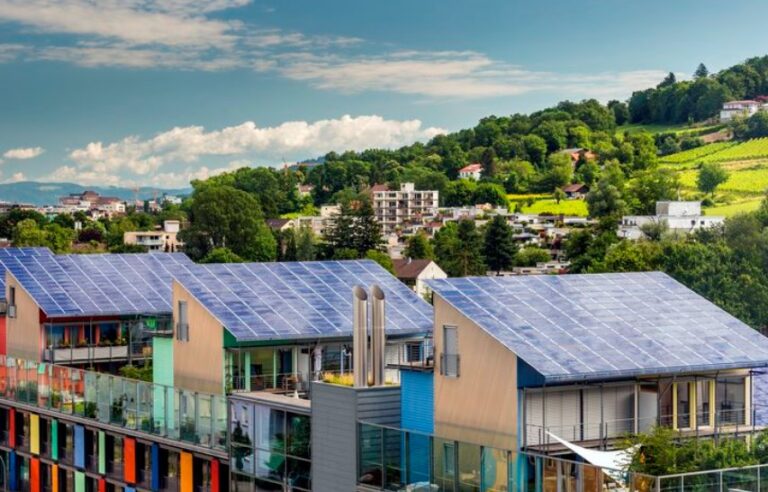Vauban, a district of Freiburg, is the first and largest ecological city on a human scale: the living example of how eco-sustainable urban planning experiments are possible. Let’s find out more.
Table of Contents
The story of Vauban
It all started in 1991 with the decision of the municipality of Freiburg, a university city of 200,000 inhabitants, in the rich land of Baden-Württemberg, to reserve its medieval heart only for pedestrians. A single tariff is introduced for public transport, both trams and buses, and only a few car parks are reserved for cars, far from the centre, encouraging the use of bicycles for all private journeys.
Hence the idea that led to the creation of the Vauban district, which is located in the area of the former French barracks. It is a 41 hectare site abandoned in 1992, but located just 4 km (15 minutes by bike or bus) from the center and crossed by a pretty stream.
What are the guidelines for the construction of Vauban
The objectives pursued by the association of citizens who acted as a handbook for the planning and design of the urban nucleus and which still dictate life within the eco-district, are in particular:
- Reduction of private cars in the neighborhood, in particular by encouraging the construction of houses without parking spaces;
- Energy saving obtained with constructions that follow the indications of bioclimatic construction and that meet the criteria of a passive house, in which extensive use of renewable sources is made;
- Greater urban livability thanks to the creation of numerous public or semi-public spaces, so as not to fall into the effect of an ‘urban and commercial desert’. That is, avoid a neighborhood without nearby shops and public services and offices;
- Respect for the environment and creation of corridors of biotopes typical of the region, to preserve the local flora;
- Reduction of soil sealing and introduction of a new technology (for the time): the vacuum treatment of feces to produce biogas;
- Promotion of ‘building collectives’ and mixed housing and workplaces.
Even now that the experiment has succeeded, its inhabitants continue to expand their neighborhood with new buildings, to allow others to live in a pleasant and eco-friendly place.
The idea of Vauban’s eco-neighbourhood
Vauban was born and developed as an initiative of its inhabitants: a group of people who lived in Freiburg wanted to build a neighborhood where they could live in their own way and so the first baugruppen were born.
Furthermore, this direct construction initiative has reduced costs and involved many who were initially hesitant. Integrating all social and commercial functions in a single urban environment is the key to the success of a new urban project. This is also the reason for Vauban’s success.
How Vauban works: cars and distances
Vauban is based above all on the idea of the ‘short distance neighbourhood’, just as the ’15 minute city’ theorem has been adopted in many cities today.
Residents can easily reach all the main services such as shops, nurseries, schools, municipal offices and tram stops on foot.
Urban planners consider the concept of short distance to be less than 700 m, but in Vauban is reduced to 300 m. A tram line connects it to the center of Freiburg, reducing the time to reach the city.
How Vauban works: the use of renewable energy
The reputation as an example city for other eco-districts is also part of a design that has taken into account how to best use renewable energy.
The buildings follow the rules for energy saving at home and the passive house guidelines, with a practically self-sufficient heating system (whose consumption is 15 kWh/m2 per year).
Many buildings comply with the most common low energy consumption standards such as LEED certification (with a consumption of 65 kWh/m2 per year).
The roofs of the buildings are covered by photovoltaic panels (2500 m2 in total) and use solar thermal energy for the production of hot water for heating and sanitary purposes (500 m2).
It was also decided to install a central heating system linked to a cogeneration plant, powered locally with pellets (80%) or biogas (20%). An efficient pipe system was installed to distribute water throughout the neighborhood. Also, rainwater is collected in cisterns and reused for daily uses (toilets, gardening, etc.).
The sustainable management of the forests surrounding the neighborhood requires them to act as thermal buffers and thus limit extreme variations in the climate, and at the same time improve air quality.
This neighborhood is the perfect example of a strong municipal and civic commitment, which has taken into account the challenges that climate change brings to urban planning, adopting an ecological and responsible approach.
Read also: What are “ecovillages”, an increasingly popular way for sustainable living






